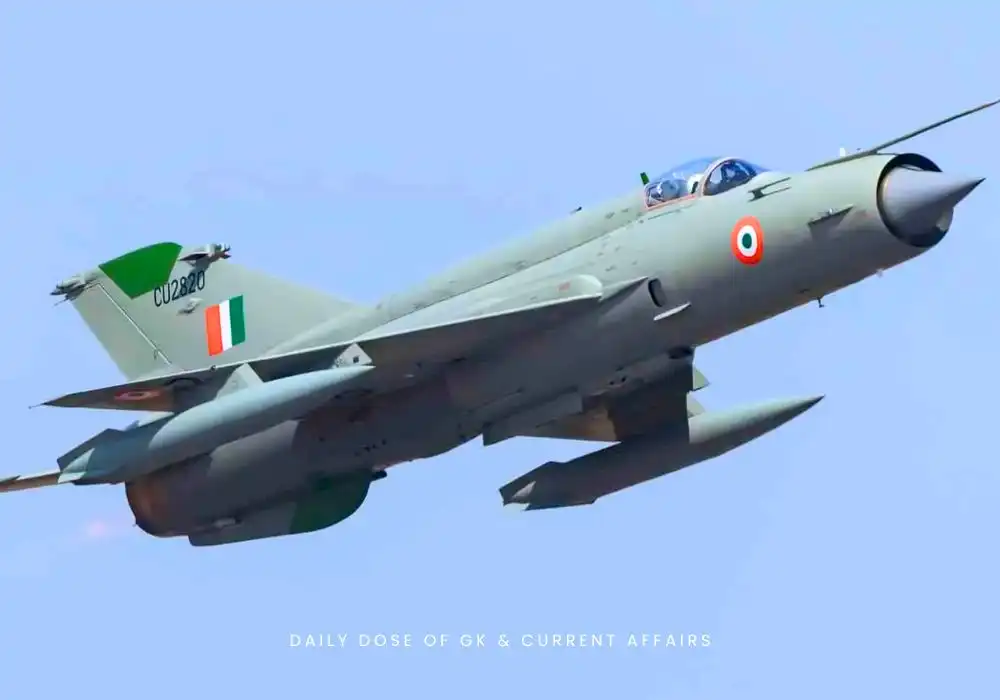Translate Language
End of an Era: What Does the MiG-21 Retirement Mean for India’s Air Power?
September 2024 marks the end of an era for the Indian Air Force (IAF). The legendary MiG-21 fighter jets, which have defended Indian airspace through major conflicts since 1963, are finally being retired. This significant defence development holds crucial lessons on modernization, safety, and policy implementation for government exam aspirants.

Get ready to bid farewell to a true aviation legend. Come September 2024, the Indian Air Force will officially retire its remaining MiG-21 Bison fighter jets, drawing the curtain on an incredible six-decade-long service career. These jets weren’t just machines; they were the backbone of India’s air defence through wars and peace, earning respect and, unfortunately, some grim nicknames along the way.
The IAF will hold a special ceremony on September 19th at the Chandigarh airbase to decommission the last two active squadrons of the MiG-21 Bison. It’s a moment steeped in history.
A Long and Storied Journey: India first welcomed the MiG-21 back in 1963. Over the years, we inducted more than 700 of these jets in various models – starting with the Type-77, moving through the Type-96 and BIS, and culminating in the upgraded Bison variant. They served valiantly in every major conflict India faced.
The Bison Upgrade: The jets retiring now are the MiG-21 Bisons – the most advanced version India flew. Think of them as classic cars fitted with modern tech. The upgrades over the last 30 years included:
New digital cockpits with multi-function displays.
A modern Kopyo radar for better targeting.
Improved navigation systems (Inertial + GPS).
Enhanced communication and electronic warfare suites.
Helmet-mounted displays for pilots.
Why the Delay in Retirement? Honestly, the plan was to phase out these older jets by 2022. But like many defence projects, replacements like the indigenous Tejas fighter faced delays. The IAF simply couldn’t retire the MiGs without having enough new jets ready to take their place. This delay highlights the complex challenges of defence procurement and modernization.
The Squadron Strength Challenge: This retirement isn’t without consequence. The IAF is already operating below its ideal strength of 42 fighter squadrons, currently having about 31. Retiring the last MiG-21s will, for now, reduce this number further, making the swift induction of new aircraft like the Tejas Mk1A even more critical for national security.
A Mixed Legacy – Heroism and Heartbreak: The MiG-21’s story isn’t simple. While they performed brilliantly in wars, their safety record became a major concern. Tragically, over 400 MiG-21s (including trainers) have crashed since induction, resulting in the loss of more than 100 pilots and some civilians. This alarming crash rate earned them nicknames like “flying coffin” and “widow maker.” The core reasons often traced back to the aircraft’s age, limitations of its original design (especially the engine and airframe, which upgrades couldn’t fully overcome), and the inherent risks of flying high-performance jets.
This retirement marks the close of a significant chapter. It’s a story of endurance, technological evolution, the bravery of countless pilots, and the critical need for timely defence modernization.
Key Q&A for Exam Aspirants
Q: When and where is the IAF officially retiring its last MiG-21 Bison squadrons?
A: The Indian Air Force will formally retire its last MiG-21 Bison squadrons in a ceremonial decommissioning on September 19, 2024, at the Chandigarh airbase.
Q: Why did the IAF continue flying the MiG-21 for so long despite safety concerns?
A: The primary reason was delays in inducting replacement aircraft (like the Tejas) to maintain the required squadron strength. Retiring them earlier without sufficient new jets would have left a significant gap in India’s air defence capabilities.
Q: What is the significance of the MiG-21 Bison upgrade?
A: The Bison upgrade significantly modernized the aging MiG-21s, enhancing their combat effectiveness. Key improvements included advanced avionics, a new multi-mode radar (Kopyo), modern navigation (INS/GPS), an electronic warfare suite, helmet-mounted displays, and better cockpit instrumentation. However, the core airframe and engine limitations remained.
Q: How will the MiG-21 retirement impact the IAF’s operational strength?
A: The retirement will further reduce the number of active IAF fighter squadrons. The IAF currently has about 31 squadrons against a sanctioned strength of 42. Phasing out the MiG-21s without immediate one-for-one replacements exacerbates this shortfall, emphasizing the urgency of new inductions.
Q: Why did the MiG-21s acquire nicknames like “flying coffin” and “widow maker”?
A: These nicknames stemmed tragically from the aircraft’s high crash rate over decades. Contributing factors included the jet’s age, design limitations (especially related to engine performance and the airframe’s handling characteristics at low speeds), the complexity of flying a high-performance aircraft, and the inherent risks of military aviation, magnified by the sheer number of accidents involving this specific type in India.
Get 3 Months Free Access for SSC, PSC, NIFT & NID
Boost your exam prep!
Use offer code WELCOME28 to get 3 months free subscription. Start preparing today!















